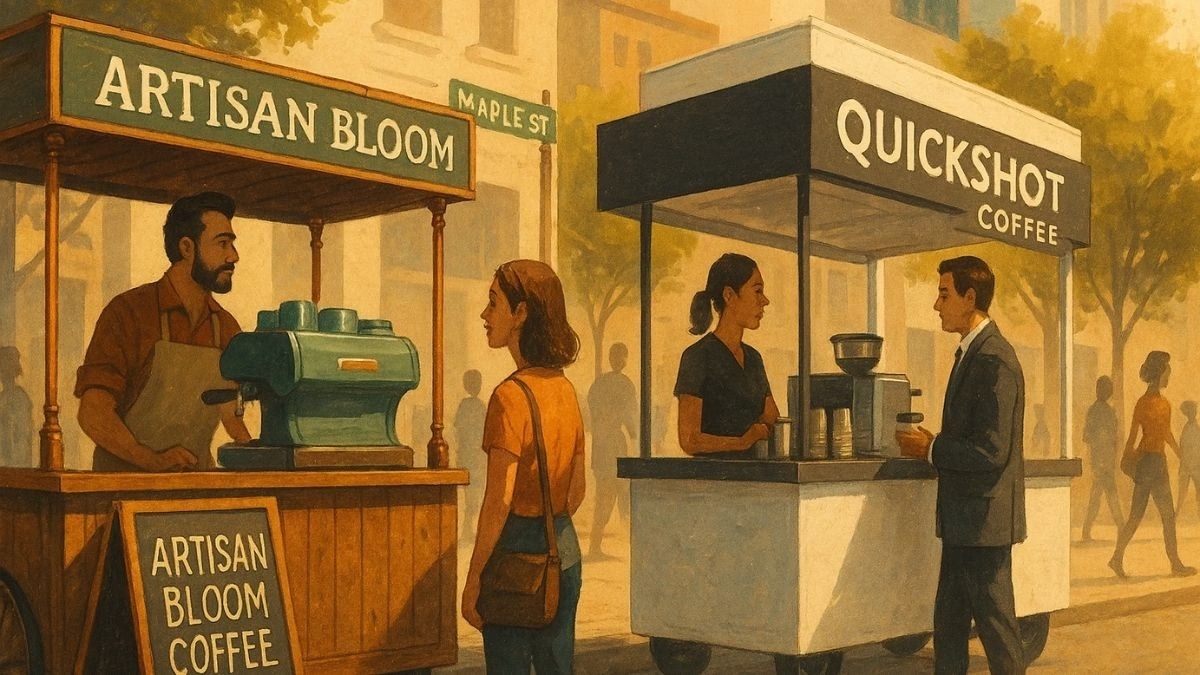Introduction
Learn about pricing, word combinations with ‘price’, upmarket and downmarket, mass market and niches.
Audio Episode
Practice Booklet (For the Entire Mini-Series)
Business English Marketing … by English Plus Podcast
Episode Transcript
welcome to episode five from the business English marketing mini series. And in this episode, we will focus on price. We talked about the four PS of marketing, which are the product price, place, and promotion. We talked about product in the previous episode today, we will talk about price. So first let’s talk about pricing.
[00:00:26] Now we have some words that I want you to know about when it comes to pricing and to do that, we will pretend that we have the owner of all Mart and the owner of luck smart, and they say different things. And then we will stop and talk about specific words they use that are very useful. And that will add to our understanding of pricing.
[00:00:47] So let’s start with the owner of Omar. As you know, our goods are low priced and this permanently low pricing means we charge low prices all the time. Our competitors say their goods are more expensive because they provide customer service. But we believe that our customers are interested in cheap products and don’t want to pay extra for service.
[00:01:11] It is true that we have lost leaders. We have a policy of selling our goods below the official list price or recommended retail price. This policy of discounting has been very successful. So before we talk about what the owner of Lux Mart says, Let’s start with a couple of key words that you could hear in what the owner of Walmart said.
[00:01:35] You said our goods are low priced. This is self-explanatory of course, low price and high price, but here low price. And he talked about the low pricing. This permanently low pricing means what is the meaning of low pricing? That means they charge less or low prices. All the time. And of course we have the words expensive and cheap, but you know, I want to focus on the expression loss leaders.
[00:01:59] He said it is true that we have lost leaders. Now, what is the meaning of lost leaders? Lost leaders are cheap items, which are there to attract customers. These are lost leaders. And he said that they sell below the official list price. The list price is the price that you can find on the product packaging sometimes.
[00:02:20] Or sometimes we have the recommended retail price retail. We will talk more about wholesale and retail when we talk about place. But for now the retail price is for consumers, not for selling a large amount of the product to companies, for example, or to other resellers or sellers. So they sell below the list price or the recommended retail price.
[00:02:42] Now the policy of discounting discounting means selling at a discount to the list price. So remember, again, we have here low priced, low pricing. We can use the word charge and of course we have the word loss leaders. The expression, lost leaders to talk about the cheap items that are there to attract customers.
[00:03:00] And we have the list price, the recommended retail price and discounting. Now that is what the owner of Omar said. What about the owner of Luxembourg? All marts goods are cheap. Our top quality goods are high priced. I agree, but we have high levels of customer service. In fact, most of our goods are mid-priced.
[00:03:21] But all Mart are undercutting us on some products here. We have the word cheap. Of course, you know what cheap means? That means low price, but not of a high quality. That is very important. When you talk about goods and say cheap, you’re not just talking about the price you insinuate that these are low priced, but not of high quality.
[00:03:42] They’re not just cheap. So when you talk about cheap prices, remember this thing goes hand in hand with quality. That’s what you mean by it. When we talk about pricing, remember we talked about pricing in the context of marketing. We’re not just talking about prices as we just go to the supermarket and we say, this is cheap and this is expensive.
[00:04:01] That’s different. We’re talking about pricing in the context of marketing. Then the owner of Lux Mart said that their top quality goods are high priced. And this is obviously the opposite of low priced. This is another way of saying expensive. Remember that we have high priced goods and we have low priced goods.
[00:04:20] We’re not talking about over priced goods, over price. That’s something else overpriced. That means a lot more expensive than they should. That is overpriced. That is another thing that you can add to the words you’re learning about pricing. But here, I’m also interested in what he said about mid priced.
[00:04:37] We have low priced, we have high priced, we have mid price and obviously mid priced means not cheap and not expensive. So it’s not always either low priced or high priced. We have low priced goods. We have high priced goods and we have something in the middle. These are mid priced goods. And he also used a very interesting verb.
[00:04:56] He said, all Mart are undercutting us on some products, undercut, what is the meaning of undercut? That means sell the same ones at lower prices than us. They sell the same products we sell, but at lower prices, if. Accompany does that. That means they’re undercutting you on some products. They’re undercutting selling at lower prices, the same things at lower prices.
[00:05:19] Now let’s continue talking about prices and we will learn some word combinations with word price. We have price, boom, price controls, price, cut, price, hike, price, war, and price. Dad. Let’s start with price. Boom. When we talk about a price, boom, that is when prices are rising quickly to the benefit of sellers.
[00:05:39] Of course, that is a price. Boom. What about price controls? Price controls. That is the government efforts to limit the amount by which prices increase. And that is very important sometimes because if you put no controls, there can be no limits. And the price boom, may go on and on until you can’t buy the products anymore.
[00:05:58] So price controls are government efforts to limit the amount by which prices increase. What about a price? Cut. A price cuts simply is a reduction on the price that is a price cut. Or what about a price hike? We know hike, you know, that’s like walking price. Hike is an increase, especially one, not wanted by the buyer.
[00:06:19] And this is a special term used by journalists. Maybe it’s not as big as a price, boom, but it is an increase nonetheless. Because a boom. Remember, uh, it’s a quick increase. The prices are rising quickly. Now hike here. It’s, doesn’t have to be quick because it’s a hike. Remember it’s not a boom. A hike is a slow walk.
[00:06:38] It’s not a fast one, but it is an increase nonetheless. And there is the price war. Now that is when competing companies reduce prices in response to each other company a starts reducing the prices of its goods, products, whatever services, then company B, because it’s competing with company a, they reduce the products as well, and they continue doing that well.
[00:06:59] That happens to the benefit of buyers, not to the benefit of sellers. Of course, the price boom happens to the benefit of sellers, but a price war usually benefits the buyers because the prices go down when there’s a price war. And finally there’s a price tag and that is the label attached to goods showing the price, and also simply means the price.
[00:07:20] When you want to know the price of something, you look at the price tag. So remember, these are combinations that we use with the word price, with announce price. And these are very important. We talked about the price, boom, price controls, price, cut, price, hike, price, war, and price tag. Now to finish this episode, let’s talk about upmarket, downmarket, mass markets, and niches.
[00:07:43] So let’s start with upmarket and downmarket products exist in different models. Take skis. For example, some are basic and others are more sophisticated and exclusive. The cheapest skis are low end or bottom end. That’s what we call the cheapest line of a product or range of a product low end or bottom end.
[00:08:04] The most expensive ones are high end, top end or premium product. So we can call the cheap ones, the cheap range in a product. We can call it the low end or the bottom end, the most expensive that’s the high end, top end or premium products. And these are designed for very expensive users or people with a lot of money.
[00:08:26] The cheapest entry level skis are intended for beginners. We call them entry-level. These are people who’ve never used, or who’ve never bought skis before and on here. Remember, we’re talking about skis as just an example, it applies to any other product you can think of. So we have the cheapest entry level skis.
[00:08:44] These are intended for beginners who have never bought skis before. And those in between called mid range. So we have low end, we have high-end or premium, and we have mid range. We also have entry level. That is what you need to begin with. If you just want to learn how to ski, you wouldn’t want to go and buy premium, unless you’re very rich and you don’t care about money, but usually just because you’re trying it out or you’re just learning, you would want to buy some entry level skis.
[00:09:11] And if you find that you like it and you want to buy something a little bit more expensive, but not premium products yet not high end, not top Indian. You can go to mid-range products. Those are in-between. We call the mid range. Now, as you grow more experienced, and maybe because you just love skiing, you don’t have to be a professional skier.
[00:09:31] You just need to love it. And to have some experience in it, you might want to buy more sophisticated skis to replace the basic ones you have. If you do that, we call that trading up or moving up market. That is the upmarket and the downmarket. So if you trade up or you move up market, you buy more sophisticated products than the basic ones that you have.
[00:09:53] In our example is skis. It can be anything else. Now, if you buy cheaper skis after buying more expensive ones might seem a little bit strange, but it happens. It’s the opposite. That means you trade down or you move downmarket. So remember you can trade up or move up market. If you buy the more sophisticated line of products, or if you go down, if you buy cheaper products after you’ve already had the expensive ones, that means you trade down or you move downmarket.
[00:10:23] But downmarket is a very special word. If you say that something is downmarket, if you describe it as downmarket, not move down market or trade down, if you say that something is downmarket, that often shows disapproval you’re criticizing distinct. For example, if a publisher takes a newspaper downmarket, That’s a totally different thing.
[00:10:42] That’s not just buying something cheaper that is making something cheaper. In our example, here, if a publisher takes a newspaper downmarket, they make it more popular, but less cultural. So that is in an attempt maybe to increase the number of readers. Now, of course here, it depends on your point of view.
[00:11:00] Some people might see that as the correct move because you’re simply selling more and some people might see that as a bad move because you’re making your newspaper less cultural, but more popular. Well, it’s up to you to think whether this is a good thing or a bad thing, but if something like this happens, we can say that somebody takes a newspaper downmarket or takes the company downmarket.
[00:11:20] Maybe you’re selling some high-end products and then a manager comes along and he makes some decisions to change the high end products or to replace the high end products with some low end products. So if that happens, that means this manager takes the company downmarket. Now again, whether this is something to criticize or not, whether to say it’s good or not, it’s up to you, but the word downmarket in this context is usually used to show disapproval.
[00:11:46] You don’t use it to say that something is good. You usually use it to criticize things. Now let’s move to mass markets and niches. Now mass market is used to talk about goods that sell in large quantities and the people who buy them. For example, family cars, and the niche is a group of buyers with specific requirements that is relatively small, but that may be profitable for companies that sell to it.
[00:12:08] For example, sports cars. So here, if you think about cars like Ford focus and other commercial cars, These are considered part of the mass market. They produce millions of these cars every year, and I’m not just talking about Ford, by the way, just an example. It could be some models of BMW, Mercedes Volkswagen, Nissan, Toyota, et cetera.
[00:12:29] All these companies have lines. They have product lines for mass market. They produce these models of cars by the thousands or even millions every year. That is the mass market, because usually the price is acceptable is reasonable. I’m not going to say cheap because these cars don’t have to be cheap, but they have to be reasonable.
[00:12:49] And that is why you make a lot of them because you can sell a lot of them. But if you talk about a niche that is a group of buyer with specific requirements, think of Lamborghini, think of Ferrari. Think of Koenigsegg. Think of all these fancy cars. You don’t find a lot of these cars because not everybody can buy these cars at the price tag they’re at.
[00:13:11] They’re very expensive, but that’s a niche market. It’s not for everybody. Now. Some companies talking about cars, some car companies, they have both, they have models for the mass market and models for niche markets. For example, the Mercedes. Mercedes has a lot of models for the mass market, but they have the for example, that’s not for everybody, a car that costs $600,000 or even more depends on the model.
[00:13:36] That’s not for everybody. That’s a niche market. So that is the difference between mass market and niche market. So remember. Upmarket downmarket, mass markets and niche markets. And by the way, niche, I know some of you will say that we’ve heard this word before it’s called niche and not niche. Well, actually it is pronounced both ways.
[00:13:54] Niches good niche is okay. Just choose the one you like the best and stick to it. So with that being said, that’ll be everything. For this episode. We talked about pricing. We talked about different word combinations with the noun price. And we talked about upmarket, downmarket, mass market and niche market or niche market.
[00:14:13] So remember if you want to practice what you’re learning here, there is the booklet that I have provided with the mini series, both on our website, English plus podcast.com and on our Patrion page. So if you want to practice what you’re learning, go to this PDF, downloadable booklet. And practice the part that has to do with the price with episode five.
[00:14:31] This is your host, Danny. Thank you very much for listening to another episode from our mini series about business English marketing. We’re still going to talk about place promotion and e-commerce. So please complete series because by completing the series, you will have a very good idea about what marketing is. [00:14:48] And more importantly, the language you need to talk about marketing in a business English context. This is your host, Danny. Thank you again for listening to this episode, I’ll see you in the next episode.










0 Comments